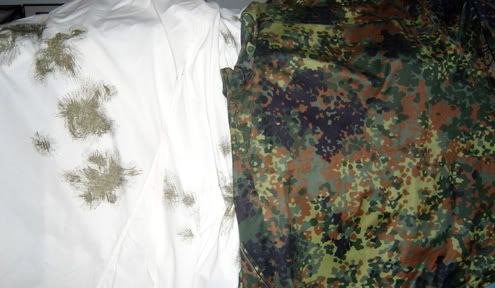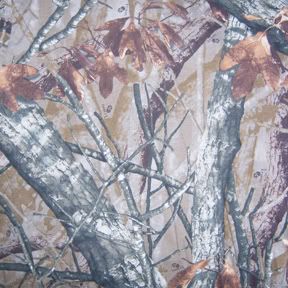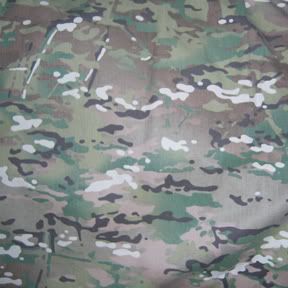
As strange as this sounds, camouflage has been a study subject of mine for years, and I have written several articles about it and was even commissioned to help with one of the US "hunter" patterns. In my research for my clients I amassed a large amount of information about the subject and even translations of the german reports from WWII on their camouflage studies.

I can without question mirror the complaints by many about the "realistic" patterns for the hunting market, not only are they on the shelf to catch hunters, they are as reported in the website links, ineffective at distance, because they blend into a single generic color losing their camouflage value, and the manufacturers know this.
I can confirm that at least the manufacturer I worked with knows this without question, and I personally had several lengthy arguments where we had photographic studies in the field showing that what they wanted to sell off the rack was no more useful than a dark brown shirt. The pattern my team developed was not only effective for the requested areas but fit the "attractive" for selling off the rack. Some of the commercial patterns fail when viewed further than 25 feet!

That company rejected the information and the superior pattern because it simply did not look like the other commercial patterns out on the marked at the time and chose a dense drawing that matched the local fauna, it looked pretty and realistic up close. It, like the other commercial patterns, looked like a photograph up close of natural debris. It just as the others fails utterly in the field. This was back in the 90's when the "camo wars" were heating up and I learned the painful lesson that you cannot trust washed up football stars, jackass hunting and gun magazine writers, and lawyers who care only about the money they can squeeze out of their sucker customers.
Regardless, pay close attention to the "micro vs. macro" research and the texture and depth theory. In the end a custom made Ghillie suit will work best, even in the desert. Currently I have aquired the Marpat, Flecktarn, and Multicam. Marpat and Multicam work great in Western state arid areas with Multicam having the edge on Marpat for arid high desert areas (similar to where I reside). Marpat also has problems with a pattern that is too small and while passing the micro, is has problems with macro (distance) colors visually grouping and loosing effectivness.
Now that there are several companies who are studied professionals working on commercial and military camouflage the next few years will provide some of the best patterns ever in history, the military use patterns have the advantage over the "catch the hunter" photographic patterns. It is a shame that typically the Army suffered from "not invented here" syndrome and rejected better patterns (like multicam) for their current uniform that they say is designed for "anywhere" and in fact sticks out everywhere, at least until dirty and stained my local materials when it actually starts to work.
One company who makes commercial camouflage that at least pass the micro/macro design requirements are:
Predator, Inc
The Science of camouflage A short introduction of modern camouflage design.
An Informal Camo Study A prospective of pattern design from a hunting user.
Military camouflage patterns and camouflage uniforms A site devoted to the study and review of military camouflage.
Science of digital camouflage design
"Digital' camouflage is actually a misnomer, based on the superficial resemblance of these patterns to quantized or coarse digital images. In fact, the pattern of squares (or whatever shape we use) is employed to model the texture of typical backgrounds using a mathematical function. We could use hexagons or shapeless blobs as well, except that it is easier to render complex patterns by computer using squares. It is easy to misunderstand the purpose and mechanisms of this kind of design, which is why so many measures that try to use the approach without insight fall short."
Now lets review the US Army and camouflage in politics.

The main thing that infuriates others keeping up with camo design is that they know Multicam was around during ACU color selection. Multicam, a camo made by Crye Precision, actually is pretty damn good at balancing performance in desert, urban, and forest. Even at its weaker side, forest, it does well (...)
Furthermore Natick actually did camo trials for the future warrior system from 2002 to 2004. Although the winner of the trials was Desert Brush, the Contractor Developed Mod (Multicam) was in the final four. UCP is amusingly only in the background of the trials powerpoint. Trials Powerpoint: All reports indicate there never were any trials for UCP.
In the camo trials powerpoint, urban track is clearly declared the worst performer. Perhaps they thought it would mysteriously beat desert brush once black was taken out?
Reliable intel sources claim a report was to have been issued last year pitting UCP against Multicam. It is said the report will probably never be released since UCP did so poorly against Multicam. Looking at our current and possible areas of operation, the optimal choice of patterns would be one for dense forest / jungle and one for urban / desert, heavier on the desert side. If we are stuck with 1 pattern, lets at least go with a good one. Lessons learned: don't go rogue during expert run trials making up your own camo and not follow up with a new set of trials.
Sounds like the crap with the M14 adoption trials mixed in with the M16 McNamara abomination in regards to NIH (Not Invented Here) and sneaky no-trial adoptions after the fact - typical.
All four patterns performed 16 to 36 percent better than the UCP across the woodland, desert and urban settings of the test, the report shows.
The Natick test follows another study involving UCP that Natick released in 2006. The “Computerized Visual Camouflage Evaluation,” conducted between November 2005 and July 2006, found that “MultiCam performed significantly better than the UCP in most conditions.”
The most recent Natick report raises questions as to why the Army’s Program Executive Soldier rejected the Marine desert digital, MultiCam and Desert Brush patterns in 2004 and chose the UCP for its Army Combat Uniform, a decision that resulted in $5 billion in uniform and equipment costs.
Army Times obtained the Natick test report from an Aug. 18 Freedom of Information Act request after Army officials refused the newspaper’s requests for the report. Camo.
WASHINGTON (Army News Service, March 1, 2010) -- Soldiers deploying to Afghanistan will be issued the new "MultiCam" fire-resistant Army Combat Uniform complete with new Mountain Combat Boots and MultiCam-patterned Modular Lightweight Load-carrying Equipment, or MOLLE, gear beginning in July.
At mobilization sites throughout the U.S., the uniform will be issued to deploying troops as part of the Rapid Fielding Initiative process, and Soldiers already in Afghanistan are scheduled to receive the MultiCam this fall.
So far, three of the four phases of exploring camouflage alternatives have been completed, while the process of making a long-term decision about the ACU, and how big a role the MultiCam camouflage will play is still up for debate.
No comments:
Post a Comment